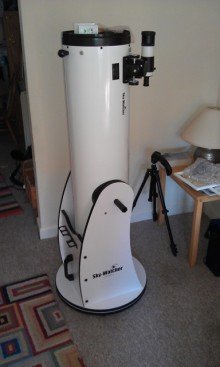There are so many brands, models, types and sizes to choose from that it can be very difficult to know which to go for. An unusable/unsuitable telescope will only bring frustration and disillusionment. Furthermore, having potentially invested in a telescope, the last thing you want is for it to languish unused in the garage, or be sold at a loss on eBay.
Never buy anything from a toy shop or museum gift shop! The boxes may feature prestigious organisations’ logos, feature amazingly detailed colour photographs of galaxies, planets and nebulae on the box, and promise ‘Up to 300 times magnification’. Take it from me, though, you’ll probably be disappointed. The optics may be technically capable of delivering that magnification, but the mount could be wobbly, the aperture small, the focuser imprecise, and, as a result, the telescope could be pretty much useless. Buy from a proper astronomy retailer, such as Tring Astro, First Light Optics or Telescope House.
There are two key aspects to telescope performance: Aperture; and focal length. Aperture is the diameter of the optical tube itself. A wider aperture will allow in more light than a smaller aperture. More aperture means you’ll be able to capture the light from fainter and more distant objects (galaxies, etc). However, more light gathering also means that a large-aperture telescope will let in any background light (street lights, moonlight, etc), thus washing out detail, and so larger-aperture scopes perform better at a dark observing site.
A smaller aperture lets in less light, which means that, although you probably won’t see a great many deep space objects (DSOs), the view will generally have more contrast (the background sky will appear darker, stars sparklier, planets crisper).
The longer the focal length the greater the potential magnification.
Think about the astronomical things that excite you, and also where you’ll be doing most of your observing. If you want to view DSOs, like distant galaxies, nebulae, etc, then you need a larger aperture and a longer focal length. Something like an 8- to 10-inch reflector with a 1200mm focal length (200-350 quid second hand). This will let you observe distant galaxies (and you may even see some detail in them, too), faint nebulae, planets, stars, etc.
If lunar, planetary and stellar observing (including solar, double stars, open clusters) floats your boat – or if storage, light pollution or weight are issues – then a smaller aperture will be fine. Something like a 3- to 4-inch refractor, or a 5- or 6-inch reflector with a 600-900mm focal length. Less good with (smaller/fainter) DSOs, but you should get great, pin-sharp views of the two main planets and the lunar surface. Views of stars will also be sharp and clear, with good contrast and colour. A small catadioptric telescope would also be a good option. Because of their design, these Maksutov/Schmitt/Cassegrain type telescopes have an incredibly long focal lengths and quite short optical tubes, but they tend to be expensive …
Do consider storage and transportation. A 10-inch reflector on a Dobsonian base weighs over 25 kilos (though it will separate into two parts).
The following rules of thumb should help with the decision making process:
• Don’t buy a scope on an equatorial (EQ) mount unless you plan to do astrophotography
• Lunar/stellar/planetary (or you observe from an urban/suburban site) – A 5- to 6-inch reflector or a 3- to 4-inch refractor on a Dobsonian or Alt/Az mount
• Galaxies/nebulae/deep space objects from a rural/dark observing site – An 8- to 10-inch+ reflector on a Dobsonian mount
There will be some overlap in performance between telescopes; there being no one scope to suit all purposes. Additionally, atmospheric conditions, light pollution and general ‘seeing’ conditions often level the playing field, and reduce the differences between the scopes themselves.
When you’re starting out, of course, you’ll want to see everything you possibly can (most of us begin with the Messier catalogue), so a good all-rounder would be the way to go. The UK’s best-selling telescope is the Sky-Watcher 8-inch reflector on a Dobsonian mount. Its 1200mm focal length gives great magnification, and its 8-inch aperture has good light gathering – a very capable telescope.
The best advice I can give to help you choose a telescope would be to go along to your local astronomy group (or find a local astronomer) and have a look through as many scopes as you can. Nothing beats trying them in person.
What’s up?
Saturn’s still usefully high at the moment, so do check it out while you can. If you’re lucky enough to have a good view of the southern horizon check out Antares (below and to the left of Saturn). It’s a red supergiant star in the tail of Scorpius. If it were at the centre of our solar system, it would extend beyond the orbit of Mars! I’d also recommend finding the double star system Alberio in Cygnus – high in the East from about 11PM. Sir Patrick Moore described Alberio as “… probably the most beautiful object of its kind in the whole sky.” While you’re in Cygnus see if you can find Deneb (the tail of the swan. It might appear unremarkable, a star like any other, but it’s in the region of 200,000 times as luminous as our sun!
Clear skies!
Kevin Quinn is an amateur astronomer based in Cerne Abbas, he is the proud owner of a ten-inch reflector, a small refractor, and a hefty pair of binoculars. He tweets via @CerneAstro, blogs via theastroguy.wordpress.com, and his ebook ‘Demystifying Astronomy – A beginner’s guide to telescopes, eyepieces and accessories for visual astronomy’ is widely available.
©Kevin Quinn







